air condition KIA Soul 2013 1.G Owner's Manual
[x] Cancel search | Manufacturer: KIA, Model Year: 2013, Model line: Soul, Model: KIA Soul 2013 1.GPages: 393, PDF Size: 8.76 MB
Page 5 of 393
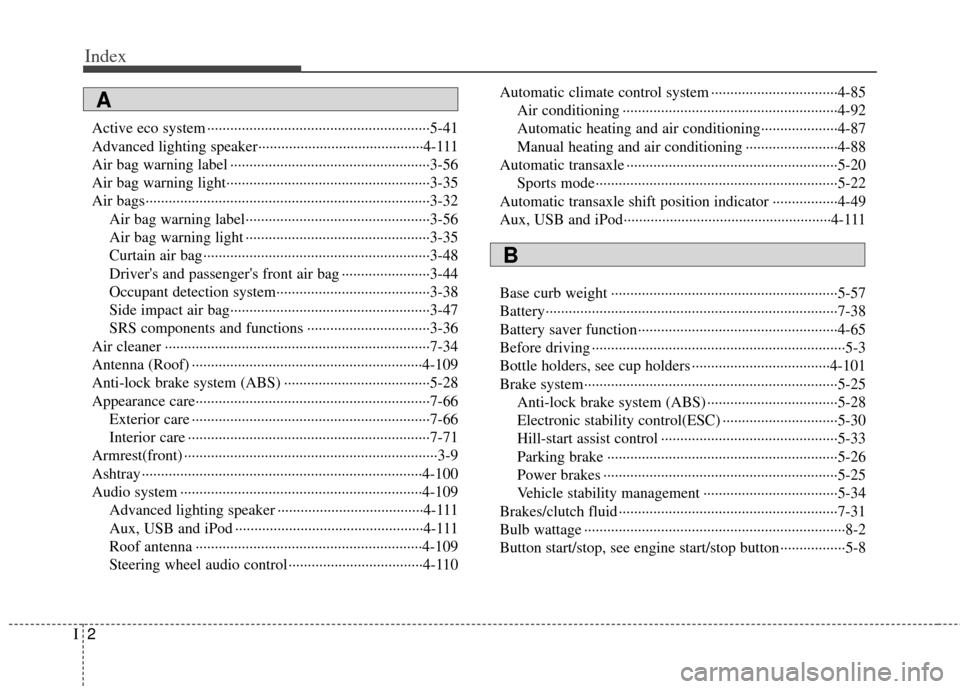
Index
2I
Active eco system ··················\
··················\
··················\
····5-41
Advanced lighting speaker··················\
··················\
·······4-111
Air bag warning label ··················\
··················\
················3-56
Air bag warning light··················\
··················\
·················3-35\
Air bags··················\
··················\
··················\
··················\
··3-32Air bag warning label··················\
··················\
············3-56
Air bag warning light ··················\
··················\
············3-35
Curtain air bag··················\
··················\
··················\
·····3-48
Driver's and passenger's front air bag ··················\
·····3-44
Occupant detection system··················\
··················\
····3-38
Side impact air bag··················\
··················\
················3-47
SRS components and functions ··················\
··············3-36
Air cleaner ··················\
··················\
··················\
···············7-34
Antenna (Roof) ··················\
··················\
··················\
······4-109
Anti-lock brake system (ABS) ··················\
··················\
··5-28
Appearance care··················\
··················\
··················\
·······7-66 Exterior care ··················\
··················\
··················\
········7-66
Interior care ··················\
··················\
··················\
·········7-71
Armrest(front) ··················\
··················\
··················\
············3-9
Ashtray ··················\
··················\
··················\
··················\
·4-100
Audio system ··················\
··················\
··················\
·········4-109 Advanced lighting speaker ··················\
··················\
··4-111
Aux, USB and iPod ··················\
··················\
·············4-111
Roof antenna ··················\
··················\
··················\
·····4-109
Steering wheel audio control··················\
·················4-110 Automatic climate control system ··················\
···············4-85
Air conditioning ··················\
··················\
··················\
··4-92
Automatic heating and air conditioning··················\
··4-87
Manual heating and air conditioning ··················\
······4-88
Automatic transaxle ··················\
··················\
··················\
·5-20 Sports mode··················\
··················\
··················\
·········5-22
Automatic transaxle shift position indicator ·················4-49\
Aux, USB and iPod··················\
··················\
··················\
4-111
Base curb weight ··················\
··················\
··················\
·····5-57
Battery··················\
··················\
··················\
··················\
····7-38
Battery saver function··················\
··················\
················4-65
Before driving ··················\
··················\
··················\
············5-3
Bottle holders, see cup holders ··················\
··················\
4-101
Brake system··················\
··················\
··················\
············5-25 Anti-lock brake system (ABS) ··················\
················5-28
Electronic stability control(ESC) ··················\
············5-30
Hill-start assist control ··················\
··················\
··········5-33
Parking brake ··················\
··················\
··················\
······5-26
Power brakes ··················\
··················\
··················\
·······5-25
Vehicle stability management ··················\
·················5-34\
Brakes/clutch fluid ··················\
··················\
··················\
···7-31
Bulb wattage ··················\
··················\
··················\
··············8-2
Button start/stop, see engine start/stop button·················5-8
A
B
Page 9 of 393
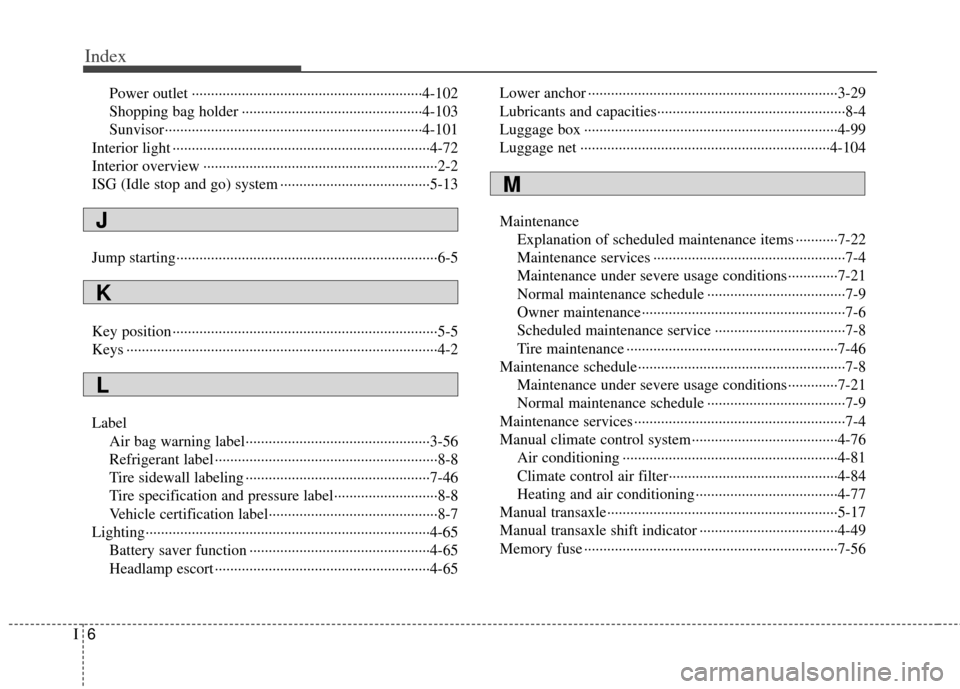
Index
6I
Power outlet ··················\
··················\
··················\
······4-102
Shopping bag holder ··················\
··················\
···········4-103
Sunvisor··················\
··················\
··················\
·············4-101
Interior light ··················\
··················\
··················\
·············4-72
Interior overview ··················\
··················\
··················\
·······2-2
ISG (Idle stop and go) system ··················\
··················\
···5-13
Jump starting··················\
··················\
··················\
··············6-5
Key position ··················\
··················\
··················\
···············5-5
Keys ··················\
··················\
··················\
··················\
·········4-2
Label Air bag warning label··················\
··················\
············3-56
Refrigerant label ··················\
··················\
··················\
····8-8
Tire sidewall labeling ··················\
··················\
············7-46
Tire specification and pressure label··················\
·········8-8
Vehicle certification label··················\
··················\
········8-7
Lighting··················\
··················\
··················\
··················\
··4-65 Battery saver function ··················\
··················\
···········4-65
Headlamp escort ··················\
··················\
··················\
··4-65 Lower anchor ··················\
··················\
··················\
···········3-29
Lubricants and capacities··················\
··················\
·············8-4
Luggage box ··················\
··················\
··················\
············4-99
Luggage net ··················\
··················\
··················\
···········4-104
Maintenance
Explanation of scheduled maintenance items ···········7-22
Maintenance services ··················\
··················\
··············7-4
Maintenance under severe usage conditions ·············7-21
Normal maintenance schedule ··················\
··················\
7-9
Owner maintenance··················\
··················\
·················7-6
Scheduled maintenance service ··················\
················7-8
Tire maintenance ··················\
··················\
··················\
·7-46
Maintenance schedule··················\
··················\
··················\
7-8 Maintenance under severe usage conditions ·············7-21
Normal maintenance schedule ··················\
··················\
7-9
Maintenance services ··················\
··················\
··················\
·7-4
Manual climate control system··················\
··················\
··4-76 Air conditioning ··················\
··················\
··················\
··4-81
Climate control air filter··················\
··················\
········4-84
Heating and air conditioning··················\
··················\
·4-77
Manual transaxle··················\
··················\
··················\
······5-17
Manual transaxle shift indicator ··················\
··················\
4-49
Memory fuse ··················\
··················\
··················\
············7-56
M
J
K
L
Page 11 of 393
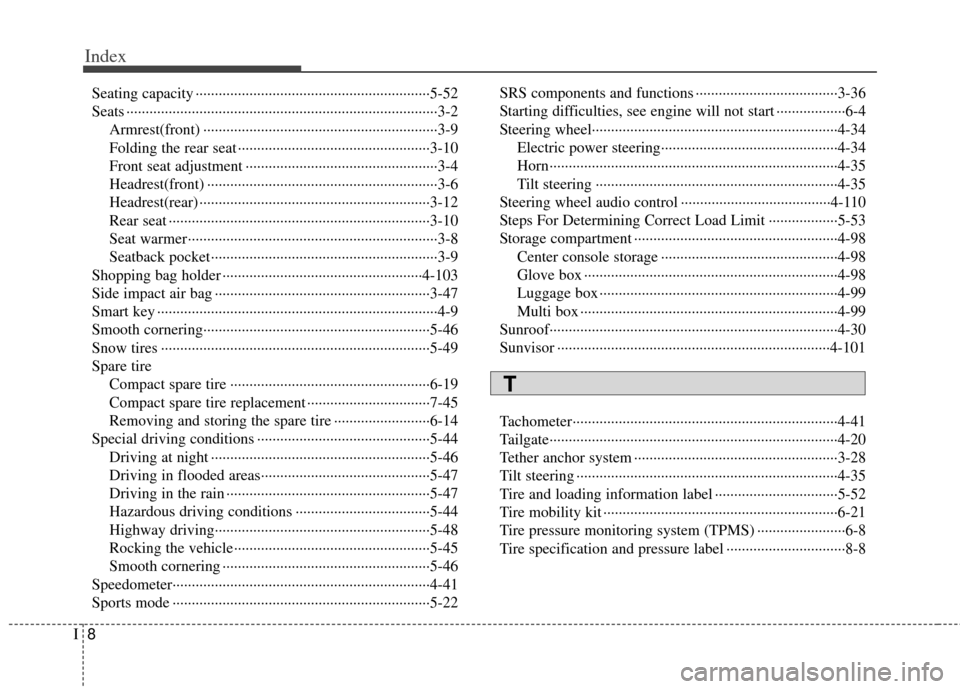
Index
8I
Seating capacity ··················\
··················\
··················\
·······5-52
Seats ··················\
··················\
··················\
··················\
·········3-2Armrest(front) ··················\
··················\
··················\
·······3-9
Folding the rear seat ··················\
··················\
··············3-10
Front seat adjustment ··················\
··················\
··············3-4
Headrest(front) ··················\
··················\
··················\
······3-6
Headrest(rear) ··················\
··················\
··················\
······3-12
Rear seat ··················\
··················\
··················\
··············3-10
Seat warmer··················\
··················\
··················\
···········3-8
Seatback pocket··················\
··················\
··················\
·····3-9
Shopping bag holder ··················\
··················\
················4-103
Side impact air bag ··················\
··················\
··················\
··3-47
Smart key ··················\
··················\
··················\
··················\
·4-9
Smooth cornering··················\
··················\
··················\
·····5-46
Snow tires ··················\
··················\
··················\
················5-49
Spare tire Compact spare tire ··················\
··················\
················6-19
Compact spare tire replacement ··················\
··············7-45
Removing and storing the spare tire ··················\
·······6-14
Special driving conditions ··················\
··················\
·········5-44 Driving at night ··················\
··················\
··················\
···5-46
Driving in flooded areas··················\
··················\
········5-47
Driving in the rain ··················\
··················\
·················5-47\
Hazardous driving conditions ··················\
·················5-44\
Highway driving··················\
··················\
··················\
··5-48
Rocking the vehicle··················\
··················\
···············5-45
Smooth cornering ··················\
··················\
··················\
5-46
Speedometer··················\
··················\
··················\
·············4-41
Sports mode ··················\
··················\
··················\
·············5-22 SRS components and functions ··················\
··················\
·3-36
Starting difficulties, see engine will not start ··················\
6-4
Steering wheel···············\
··················\
··················\
·············4-34
Electric power steering··················\
··················\
··········4-34
Horn··················\
··················\
··················\
··················\
···4-35
Tilt steering ··················\
··················\
··················\
·········4-35
Steering wheel audio control ··················\
··················\
···4-110
Steps For Determining Correct Load Limit ··················\
5-53
Storage compartment ··················\
··················\
·················4-98\
Center console storage ··················\
··················\
··········4-98
Glove box ··················\
··················\
··················\
············4-98
Luggage box ··················\
··················\
··················\
········4-99
Multi box ··················\
··················\
··················\
·············4-99
Sunroof··················\
··················\
··················\
··················\
···4-30
Sunvisor ··················\
··················\
··················\
·················4-10\
1
Tachometer··················\
··················\
··················\
···············4-41
Tailgate··················\
··················\
··················\
··················\
···4-20
Tether anchor system ··················\
··················\
·················3-28\
Tilt steering ··················\
··················\
··················\
··············4-35
Tire and loading information label ··················\
··············5-52
Tire mobility kit ··················\
··················\
··················\
·······6-21
Tire pressure monitoring system (TPMS) ··················\
·····6-8
Tire specification and pressure label ··················\
·············8-8
T
Page 59 of 393
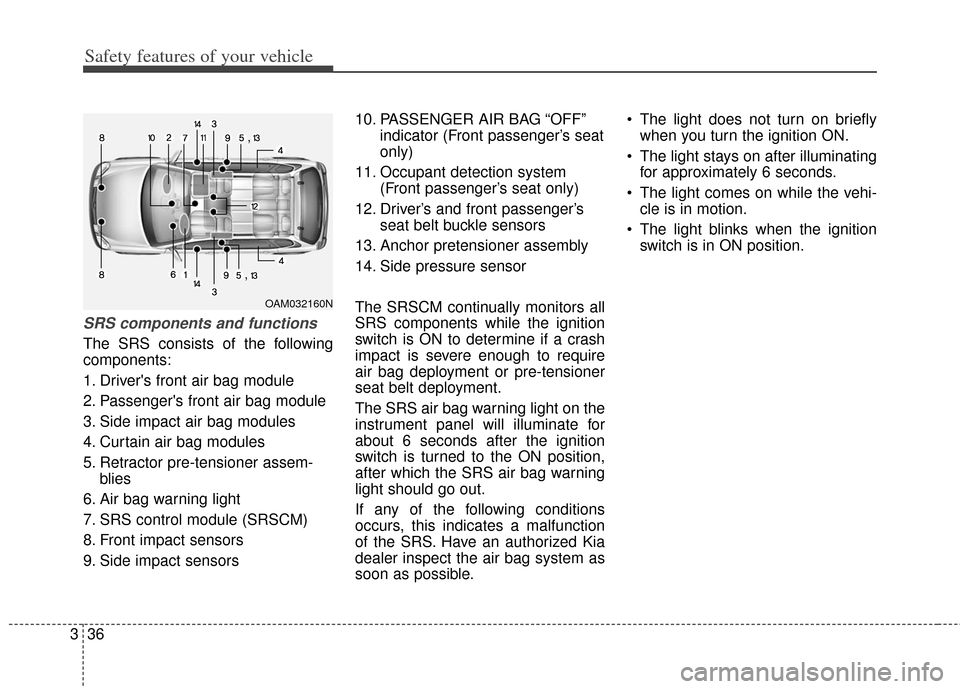
Safety features of your vehicle
36
3
SRS components and functions
The SRS consists of the following
components:
1. Driver's front air bag module
2. Passenger's front air bag module
3. Side impact air bag modules
4. Curtain air bag modules
5. Retractor pre-tensioner assem-
blies
6. Air bag warning light
7. SRS control module (SRSCM)
8. Front impact sensors
9. Side impact sensors 10. PASSENGER AIR BAG “OFF”
indicator (Front passenger’s seat
only)
11. Occupant detection system (Front passenger’s seat only)
12. Driver’s and front passenger’s seat belt buckle sensors
13. Anchor pretensioner assembly
14. Side pressure sensor
The SRSCM continually monitors all
SRS components while the ignition
switch is ON to determine if a crash
impact is severe enough to require
air bag deployment or pre-tensioner
seat belt deployment.
The SRS air bag warning light on the
instrument panel will illuminate for
about 6 seconds after the ignition
switch is turned to the ON position,
after which the SRS air bag warning
light should go out.
If any of the following conditions
occurs, this indicates a malfunction
of the SRS. Have an authorized Kia
dealer inspect the air bag system as
soon as possible. The light does not turn on briefly
when you turn the ignition ON.
The light stays on after illuminating for approximately 6 seconds.
The light comes on while the vehi- cle is in motion.
The light blinks when the ignition switch is in ON position.
OAM032160N
,
,
Page 62 of 393
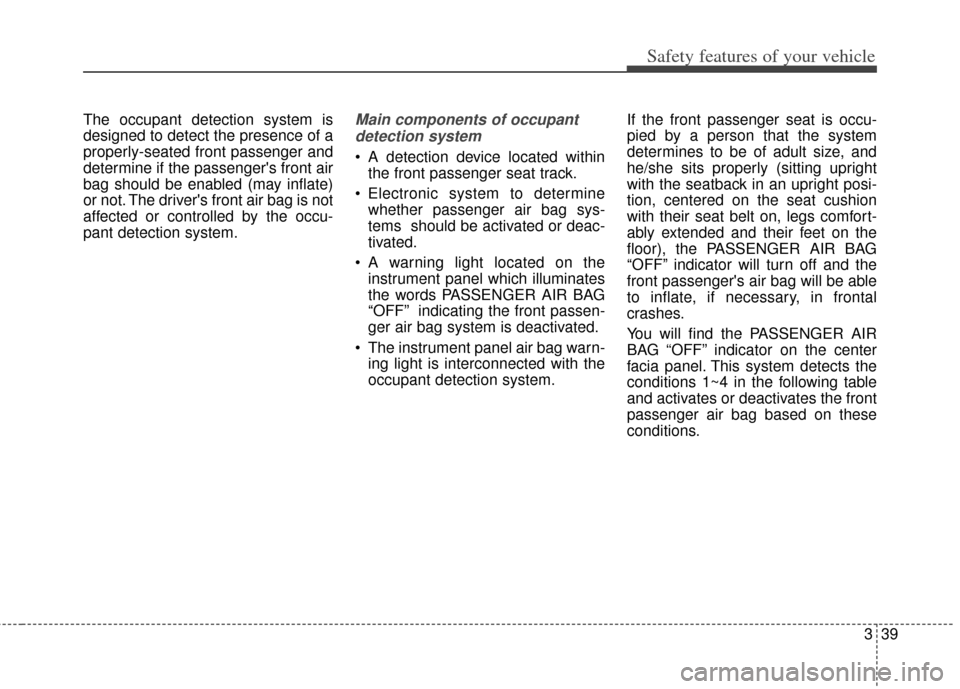
339
Safety features of your vehicle
The occupant detection system is
designed to detect the presence of a
properly-seated front passenger and
determine if the passenger's front air
bag should be enabled (may inflate)
or not. The driver's front air bag is not
affected or controlled by the occu-
pant detection system.Main components of occupantdetection system
A detection device located within the front passenger seat track.
Electronic system to determine whether passenger air bag sys-
tems should be activated or deac-
tivated.
A warning light located on the instrument panel which illuminates
the words PASSENGER AIR BAG
“OFF” indicating the front passen-
ger air bag system is deactivated.
The instrument panel air bag warn- ing light is interconnected with the
occupant detection system. If the front passenger seat is occu-
pied by a person that the system
determines to be of adult size, and
he/she sits properly (sitting upright
with the seatback in an upright posi-
tion, centered on the seat cushion
with their seat belt on, legs comfort-
ably extended and their feet on the
floor), the PASSENGER AIR BAG
“OFF” indicator will turn off and the
front passenger's air bag will be able
to inflate, if necessary, in frontal
crashes.
You will find the PASSENGER AIR
BAG “OFF” indicator on the center
facia panel. This system detects the
conditions 1~4 in the following table
and activates or deactivates the front
passenger air bag based on these
conditions.
Page 64 of 393
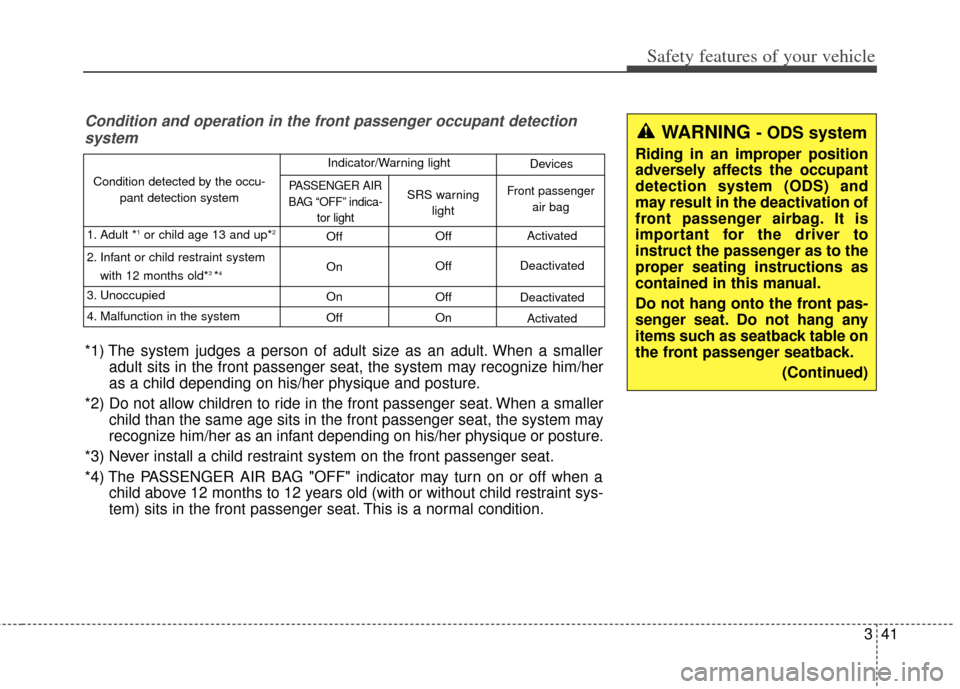
341
Safety features of your vehicle
Condition and operation in the front passenger occupant detectionsystem
*1) The system judges a person of adult size as an adult. When a smaller adult sits in the front passenger seat, the system may recognize him/her
as a child depending on his/her physique and posture.
*2) Do not allow children to ride in the front passenger seat. When a smaller child than the same age sits in the front passenger seat, the system may
recognize him/her as an infant depending on his/her physique or posture.
*3) Never install a child restraint system on the front passenger seat.
*4) The PASSENGER AIR BAG "OFF" indicator may turn on or off when a child above 12 months to 12 years old (with or without child restraint sys-
tem) sits in the front passenger seat. This is a normal condition.
Condition detected by the occu-
pant detection system
1. Adult *
1or child age 13 and up*2
2. Infant or child restraint system with 12 months old*3 *4
3. Unoccupied
4. Malfunction in the system Off
On
On
Off Off
Off
Off
On Activated
Deactivated
Deactivated Activated
PASSENGER AIR
BAG “OFF” indica- tor lightSRS warninglightFront passenger air bag
Indicator/Warning light Devices
WARNING - ODS system
Riding in an improper position
adversely affects the occupant
detection system (ODS) and
may result in the deactivation of
front passenger airbag. It is
important for the driver to
instruct the passenger as to the
proper seating instructions as
contained in this manual.
Do not hang onto the front pas-
senger seat. Do not hang any
items such as seatback table on
the front passenger seatback.
(Continued)
Page 68 of 393
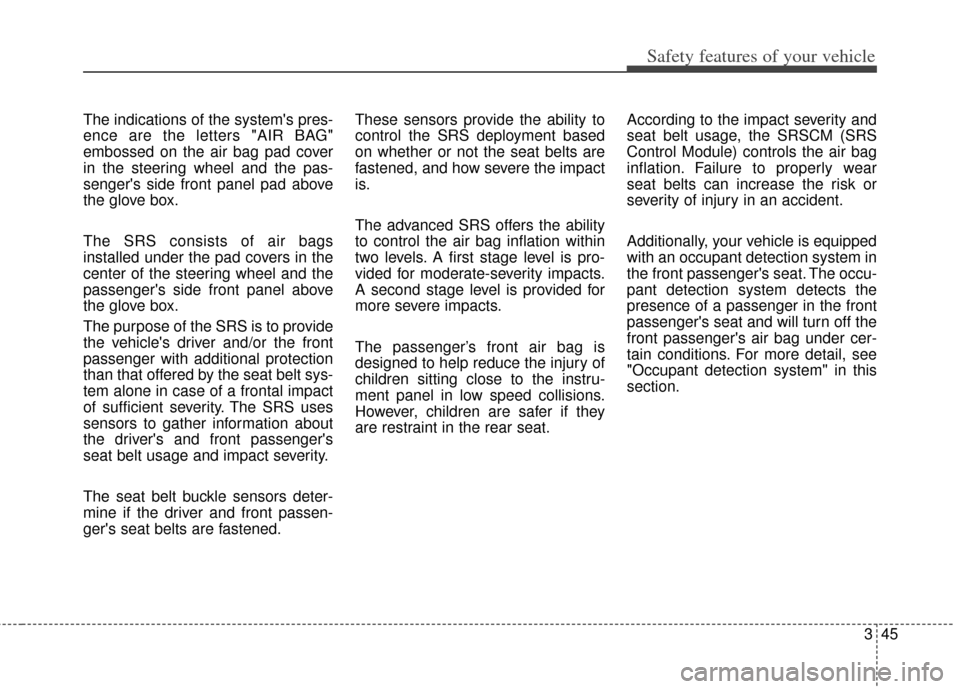
345
Safety features of your vehicle
The indications of the system's pres-
ence are the letters "AIR BAG"
embossed on the air bag pad cover
in the steering wheel and the pas-
senger's side front panel pad above
the glove box.
The SRS consists of air bags
installed under the pad covers in the
center of the steering wheel and the
passenger's side front panel above
the glove box.
The purpose of the SRS is to provide
the vehicle's driver and/or the front
passenger with additional protection
than that offered by the seat belt sys-
tem alone in case of a frontal impact
of sufficient severity. The SRS uses
sensors to gather information about
the driver's and front passenger's
seat belt usage and impact severity.
The seat belt buckle sensors deter-
mine if the driver and front passen-
ger's seat belts are fastened.These sensors provide the ability to
control the SRS deployment based
on whether or not the seat belts are
fastened, and how severe the impact
is.
The advanced SRS offers the ability
to control the air bag inflation within
two levels. A first stage level is pro-
vided for moderate-severity impacts.
A second stage level is provided for
more severe impacts.
The passenger’s front air bag is
designed to help reduce the injury of
children sitting close to the instru-
ment panel in low speed collisions.
However, children are safer if they
are restraint in the rear seat.
According to the impact severity and
seat belt usage, the SRSCM (SRS
Control Module) controls the air bag
inflation. Failure to properly wear
seat belts can increase the risk or
severity of injury in an accident.
Additionally, your vehicle is equipped
with an occupant detection system in
the front passenger's seat. The occu-
pant detection system detects the
presence of a passenger in the front
passenger's seat and will turn off the
front passenger's air bag under cer-
tain conditions. For more detail, see
"Occupant detection system" in this
section.
Page 73 of 393

Safety features of your vehicle
50
3
Why didn’t my air bag go off in a
collision? (Inflation and non-infla-
tion conditions of the air bag)
There are many types of accidents
in which the air bag would not be
expected to provide additional
protection.
These include rear impacts, sec-
ond or third collisions in multiple
impact accidents, as well as low
speed impacts. In other words,
just because your vehicle is dam-
aged and even if it is totally unus-
able, don’t be surprised that the
air bags did not inflate.
Air bag collision sensors
(1) SRS control module
(2) Front impact sensors (3) Side impact sensors
(4) Side pressure sensor
OAM032030N/OAM039031/OAM032032/OAM039033/OAM032076N
1234
Page 74 of 393
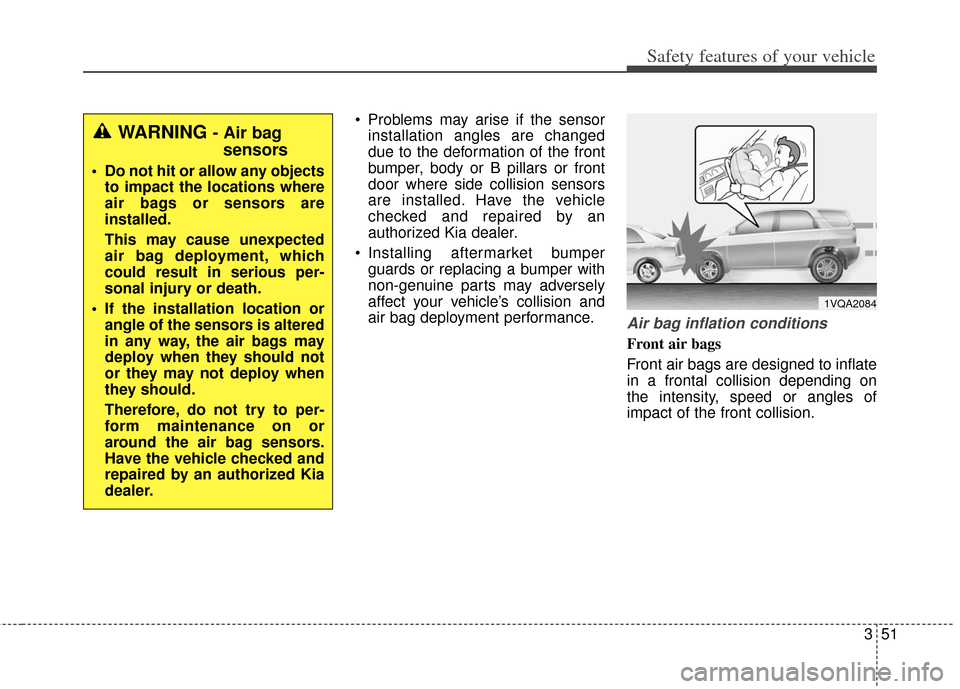
351
Safety features of your vehicle
Problems may arise if the sensorinstallation angles are changed
due to the deformation of the front
bumper, body or B pillars or front
door where side collision sensors
are installed. Have the vehicle
checked and repaired by an
authorized Kia dealer.
Installing aftermarket bumper guards or replacing a bumper with
non-genuine parts may adversely
affect your vehicle’s collision and
air bag deployment performance.
Air bag inflation conditions
Front air bags
Front air bags are designed to inflate
in a frontal collision depending on
the intensity, speed or angles of
impact of the front collision.
1VQA2084
WARNING - Air bag sensors
Do not hit or allow any objects
to impact the locations where
air bags or sensors are
installed.
This may cause unexpected
air bag deployment, which
could result in serious per-
sonal injury or death.
If the installation location or angle of the sensors is altered
in any way, the air bags may
deploy when they should not
or they may not deploy when
they should.
Therefore, do not try to per-
form maintenance on or
around the air bag sensors.
Have the vehicle checked and
repaired by an authorized Kia
dealer.
Page 75 of 393
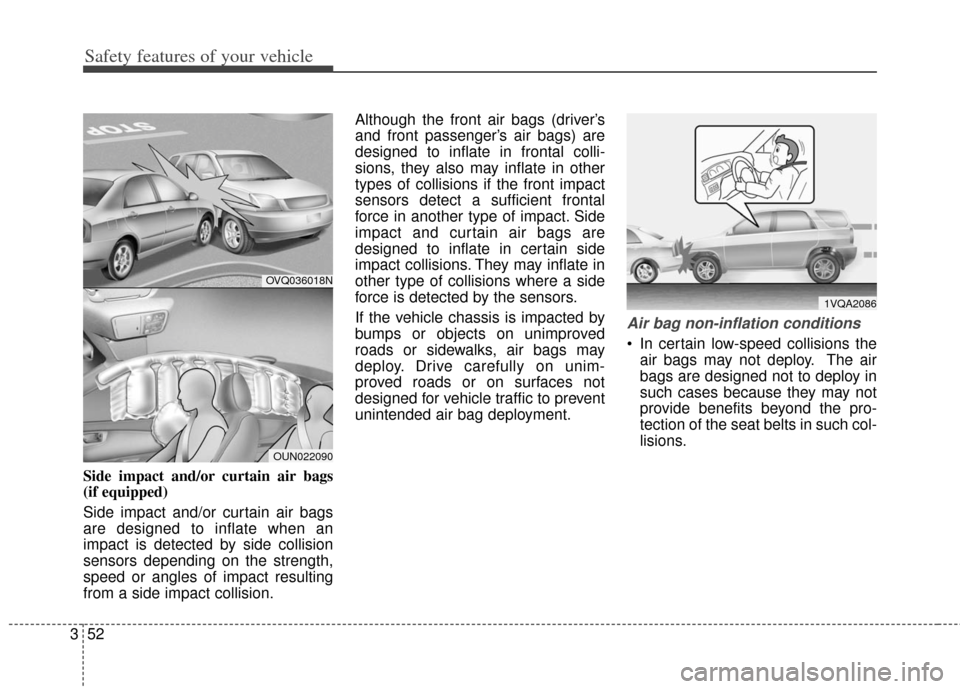
Safety features of your vehicle
52
3
Side impact and/or curtain air bags
(if equipped)
Side impact and/or curtain air bags
are designed to inflate when an
impact is detected by side collision
sensors depending on the strength,
speed or angles of impact resulting
from a side impact collision. Although the front air bags (driver’s
and front passenger’s air bags) are
designed to inflate in frontal colli-
sions, they also may inflate in other
types of collisions if the front impact
sensors detect a sufficient frontal
force in another type of impact. Side
impact and curtain air bags are
designed to inflate in certain side
impact collisions. They may inflate in
other type of collisions where a side
force is detected by the sensors.
If the vehicle chassis is impacted by
bumps or objects on unimproved
roads or sidewalks, air bags may
deploy. Drive carefully on unim-
proved roads or on surfaces not
designed for vehicle traffic to prevent
unintended air bag deployment.
Air bag non-inflation conditions
In certain low-speed collisions the
air bags may not deploy. The air
bags are designed not to deploy in
such cases because they may not
provide benefits beyond the pro-
tection of the seat belts in such col-
lisions.
1VQA2086
OVQ036018N
OUN022090